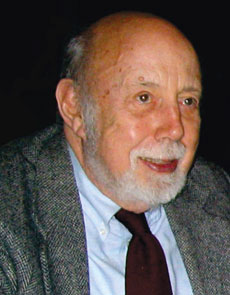Frank Bethune McDonald
DOI: 10.1063/PT.3.2054
Frank Bethune McDonald, a pioneer of space research and exploration, died on 31 August 2012; he collapsed after a presentation he’d made at a University of Michigan scientific symposium. Frank studied energetic particles in space up until his death. Many of his enduring contributions are associated with his long career at NASA, where he encouraged and supported a broad range of scientific missions and collaborations.
Born on 28 May 1925 in Gastonia, North Carolina, Frank grew up in the South during the Depression. He enlisted in the US Navy in 1943. After three years of active duty at sea, he enrolled at Duke University, where he graduated Phi Beta Kappa in 1950 with a degree in physics.
Frank then began graduate studies in physics under the direction of Edward Ney at the University of Minnesota. He quickly established himself there as a bit of a hell-raiser but also as an innovative and careful experimentalist. Ney and his graduate student Phyllis Freier, using photographic emulsions, had just discovered the presence of heavy nuclei in galactic cosmic rays. At the same time, high-altitude balloons had been developed by the Office of Naval Research, General Mills, and the university. In designing his own balloon-borne instrument, Frank moved away from emulsions and instead used a cloud chamber and scintillator detector. For his PhD thesis, he conducted balloon flights at different geomagnetic latitudes and used Earth’s magnetic field as a momentum analyzer to measure the energy spectrum of primary cosmic-ray alpha particles. He received his PhD in 1955 and then took a postdoctoral position at the University of Iowa under James Van Allen.
At Iowa, he collaborated with William Webber and developed a balloon-borne Cherenkov and scintillator detector telescope. Those electronic detectors were exactly what were needed for spacecraft instrumentation. By contrast, photographic emulsions had no time information and required retrieval for scanning, which made them impractical for spacecraft.
In October 1957 the Russians embarrassed the US at the peak of the cold war by launching Sputnik 1. In 1959 NASA recruited Frank to help bring the US into the space age as rapidly as possible. As head of the energetic-particles branch at the newly established Goddard Space Flight Center in Greenbelt, Maryland, Frank created the Interplanetary Monitoring Platform (IMP) spacecraft program to chart radiation hazards posed to astronauts by solar flares and galactic cosmic rays. Frank insisted that the project have a strong emphasis on scientific discovery, which led to one of the most productive series of scientific satellites in NASA’s history.
Frank was project scientist for Explorers 12 and 14 and the first six IMPs and was a principal investigator on all eight IMPs and Pioneers 10 and 11. Voyagers 1 and 2, launched in 1977 and now at 124 AU (18.6 billion kilometers) and 102 AU from the Sun, respectively, still return data from instruments mostly built at Goddard under Frank’s guidance. In late July 2012, Voyager 1 obtained the first evidence of a new boundary in the solar system. Voyager 1 abruptly entered a new region of space in late August 2012, but it is still unclear whether it has reached interstellar space.
From 1970 to 1982 Frank was the chief of Goddard’s Laboratory for High Energy Astrophysics. Concurrently, he was a part-time professor at the University of Maryland, where he taught core undergraduate and advanced graduate courses in astrophysics and cosmic-ray physics. Eighteen Maryland students received their PhDs under his supervision at Goddard. In 1982 Frank went to NASA headquarters in Washington, DC, as NASA’s chief scientist, a position he held for five years before returning to Goddard. In 1989 he became senior research scientist in the Institute for Physical Science and Technology at the University of Maryland, where he spent the rest of his career analyzing energetic particle data from Pioneers 10 and 11 and Voyagers 1 and 2, the first four spacecraft to have enough energy to escape the solar system. He and Ken McCracken used cosmogenic nuclei to trace solar activity over the past 10 000 years.
Frank’s influence extended far beyond the study of energetic particles in space. He developed a program to research astrophysical x rays and created the x-ray branch at Goddard in 1970 under the leadership of Elihu Boldt. He also formed groups at Goddard to study cosmic gamma rays and IR emission. The IR emission group led to the Cosmic Background Explorer and other IR missions. COBE made detailed studies of the 3-K background emission, a remnant of the Big Bang. John Mather, who was hired by Frank, was a corecipient of the 2006 Nobel Prize in Physics for his work on COBE.
Frank established enduring friendships with talented, dedicated scientists, engineers, and technicians. He engaged his friends and colleagues in new projects and continued his work right up to his death. He had a healthy disrespect for authority and followed the rule “Proceed until apprehended” with great success. Also known as NASA’s “chef scientist,” he loved to entertain and cook for a houseful of colleagues and friends. The last such occasion was just a week before he died.

Frank Bethune McDonald

More about the Authors
Tycho von Rosenvinge. Goddard Space Flight Center, Greenbelt, Maryland.
Michael Coplan. University of Maryland, College Park.
